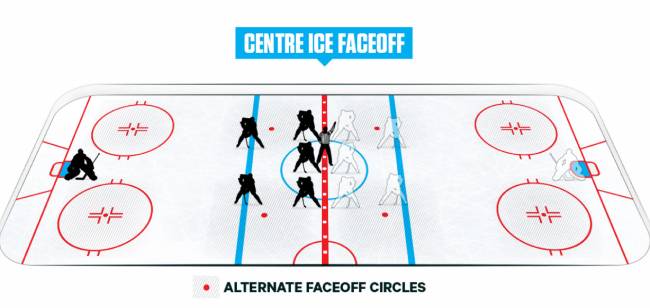In every high school, college, AHL, Canadian, international, and NHL game, there is a face-off at the center ice. Each team (home and visiting) sends one player to line up at the ice center while waiting for the official to drop the puck. Find out what the circles on the ice mean, why hockey players get kicked out, and more about face-off rules!
Table of Contents
What are the Rule of a Face-Off in Hockey?
At the hockey face-off dot, two centers line up across each other and await the referee’s drop of the puck. The remaining players should line up 15 feet away from the puck. The only players who can line up inside this circle on the ice are the two centers. Once the puck drops, the game begins or resumes, and no violations are committed.
When Do Face-Offs in Hockey Occur?
In hockey, face-offs occur for a variety of reasons. At the beginning of every period, there is a face-off. Whenever a period begins, the puck drops in the center of the ice between the two teams.
In addition, a face-off occurs after either team scores a goal. As soon as that goal is scored, the ice hockey official grabs the puck and skates back to the center of the rink to drop it between the opposing players.
Thirdly, whenever a puck goes out of play or an injury causes a delay, there will be a face-off. It is at the point of the stoppage of action that the puck drops.
The fourth rule is that whenever a penalty is called, there will be a face-off. As an example, if one team gets a tripping penalty, the referee will blow their whistle once the team touches the puck again. To begin the action, a face-off will be held near the face-off circles on the penalized team.

How Many Different Face-Off Spots are There on the Ice?
On the ring, there are nine zones for face-offs, and one in the center of the ice. After a goal or at the beginning of a period, the center ice face-off occurs. Eight of the remaining face-off locations are based on where a penalty occurred.
Around the center ice face-off circle, there are four red face-off dots. In this area, there are two blue lines that indicate the neutral zone. In most cases, the referee will decide to have the face-off in the neutral zone if there was an offsides penalty or if the puck left the rink here.
The other four face-off circles are near the goaltender section. The goalie holding on to the puck from a shot is an example of a face-off in this area. Keeping hold of the puck causes a halt in action, resulting in a face-off.
Why Does a Player get Kicked Out of the Face-Off Circle in Hockey?
A teammate’s mistake can lead to you being kicked out of the face-off circle. After a first violation, a new player enters the circle to take the face-off, but a second violation results in a minor penalty. In hockey, there are several reasons why you might be kicked out of a face-off.
If a player’s skates are not squared up, the linesman will kick them out of the face-off circle. Once the puck drops from the referee, skates that aren’t squared up can’t be angled to push the puck.
As the offensive player waits for the puck, you must wait for the defensive center to place his stick on the ice first. The face-off circle will be removed if the offensive player puts their stick down before the defensive player.
The third rule is that if you move too early and don’t have your skates in the red L shape, you will be kicked out of the face-off. Players can also be kicked out of the face-off if their teammate enters the circle too early.
Is there a Penalty for a Face-Off Violation?
An official hockey rule states that if a team violates the face-off rule back-to-back, they will receive a bench minor penalty. A minor penalty puts a player on the offending team in the penalty box for two minutes, giving the opposing team an advantage. When a player is sent to the penalty box, the other team can take advantage of a power play.
Why Do Players Get in Trouble Before a Face-Off?
A team’s possession of the puck is an essential metric. When teams control the puck during a game, they have fewer chances for the other team to score. In spite of that, some players create a violation due to their aggressive playstyle when attempting to capture the puck.
Can a Goalie Take a Face-Off in Hockey?
During a hockey game, goalkeepers cannot take any face-offs.
Is there a Stat that Counts Face-Off Wins in Hockey?
Fantasy ice hockey owners and fans are familiar with Face-off Wins (FW). The face-off win percentage is calculated by dividing the total number of face-off opportunities by the total number of face-off wins. In the past year, you participated in 85 face-offs and won 48 of them. In other words, you won 56% of the face-offs.
As of December 2021, Yanic Perreault has the best face-off win percentage with 61.14%.
Who Has the Most Face-Off Wins in NHL History?
According to Quanthockey.com, Patrice Bergeron has 13,402 face-off wins as of December 2021. The second most is held by Joe Thornton with 13,366. You can see the entire list of players and face-off wins by visiting Quant Hockey’s link.
What Happens After the Puck Drop?
After the referee drops the puck on the ice, the other players can crash the circle to retrieve it. However, teams design plays so that some players crash the puck while others wait for a potential pass.
Conclusion: What is a Face-Off in Hockey?
During ice hockey, a face-off either begins the match or occurs immediately after an infraction. During the face-off, each team sends one player to the spot where the puck will drop. In addition to boosting your team’s morale, winning the face-off can give you more time with the puck, which is why teams work on face-off plays during practice all season.
FAQs
A faceoff violation occurs when players switch during a faceoff. If a player does something outside of the faceoff procedure set by the rules before the puck is dropped, that is a faceoff violation.
In the event of a faceoff violation, the team committing the violation must replace the faceoff person with another member of the team on the ice to take the faceoff. When the team receives a faceoff violation, the players must immediately switch to the player taking the faceoff, or else the linesman will drop the puck. For two faceoff violations on the same faceoff, a team will receive a 2-minute penalty.
A faceoff win is determined by which team controls possession of the puck after the faceoff. The first to touch the puck does not determine the winner. When a player touches the puck first, the other team can still push the puck to gain possession and win the draw. Possession of the puck counts, not first contact.
